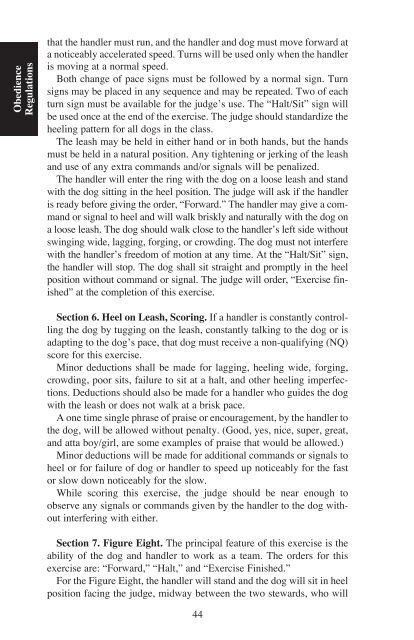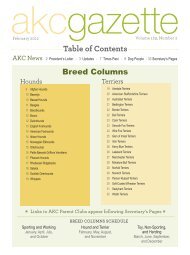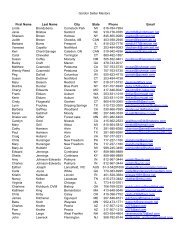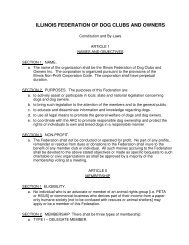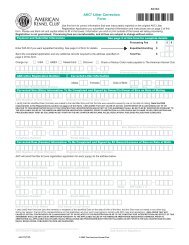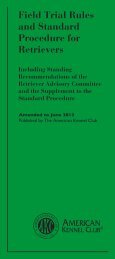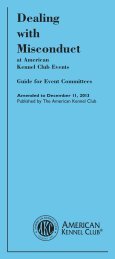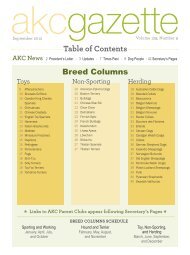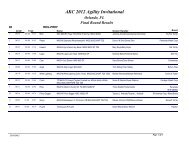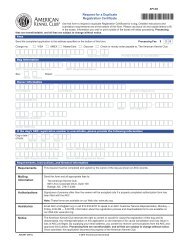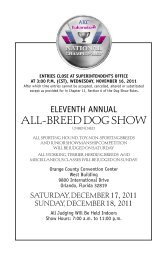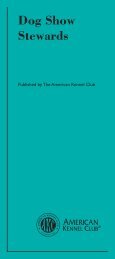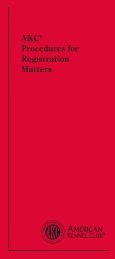Obedience Regulations - American Kennel Club
Obedience Regulations - American Kennel Club
Obedience Regulations - American Kennel Club
You also want an ePaper? Increase the reach of your titles
YUMPU automatically turns print PDFs into web optimized ePapers that Google loves.
<strong>Obedience</strong><br />
<strong>Regulations</strong><br />
that the handler must run, and the handler and dog must move forward at<br />
a noticeably accelerated speed. turns will be used only when the handler<br />
is moving at a normal speed.<br />
both change of pace signs must be followed by a normal sign. turn<br />
signs may be placed in any sequence and may be repeated. two of each<br />
turn sign must be available for the judge’s use. the “Halt/sit” sign will<br />
be used once at the end of the exercise. the judge should standardize the<br />
heeling pattern for all dogs in the class.<br />
the leash may be held in either hand or in both hands, but the hands<br />
must be held in a natural position. Any tightening or jerking of the leash<br />
and use of any extra commands and/or signals will be penalized.<br />
the handler will enter the ring with the dog on a loose leash and stand<br />
with the dog sitting in the heel position. the judge will ask if the handler<br />
is ready before giving the order, “Forward.” the handler may give a command<br />
or signal to heel and will walk briskly and naturally with the dog on<br />
a loose leash. the dog should walk close to the handler’s left side without<br />
swinging wide, lagging, forging, or crowding. the dog must not interfere<br />
with the handler’s freedom of motion at any time. At the “Halt/sit” sign,<br />
the handler will stop. the dog shall sit straight and promptly in the heel<br />
position without command or signal. the judge will order, “exercise finished”<br />
at the completion of this exercise.<br />
Section 6. Heel on Leash, Scoring. if a handler is constantly controlling<br />
the dog by tugging on the leash, constantly talking to the dog or is<br />
adapting to the dog’s pace, that dog must receive a non-qualifying (nQ)<br />
score for this exercise.<br />
minor deductions shall be made for lagging, heeling wide, forging,<br />
crowding, poor sits, failure to sit at a halt, and other heeling imperfections.<br />
Deductions should also be made for a handler who guides the dog<br />
with the leash or does not walk at a brisk pace.<br />
A one time single phrase of praise or encouragement, by the handler to<br />
the dog, will be allowed without penalty. (Good, yes, nice, super, great,<br />
and atta boy/girl, are some examples of praise that would be allowed.)<br />
minor deductions will be made for additional commands or signals to<br />
heel or for failure of dog or handler to speed up noticeably for the fast<br />
or slow down noticeably for the slow.<br />
While scoring this exercise, the judge should be near enough to<br />
observe any signals or commands given by the handler to the dog without<br />
interfering with either.<br />
Section 7. Figure Eight. the principal feature of this exercise is the<br />
ability of the dog and handler to work as a team. the orders for this<br />
exercise are: “Forward,” “Halt,” and “exercise Finished.”<br />
For the Figure eight, the handler will stand and the dog will sit in heel<br />
position facing the judge, midway between the two stewards, who will<br />
44


